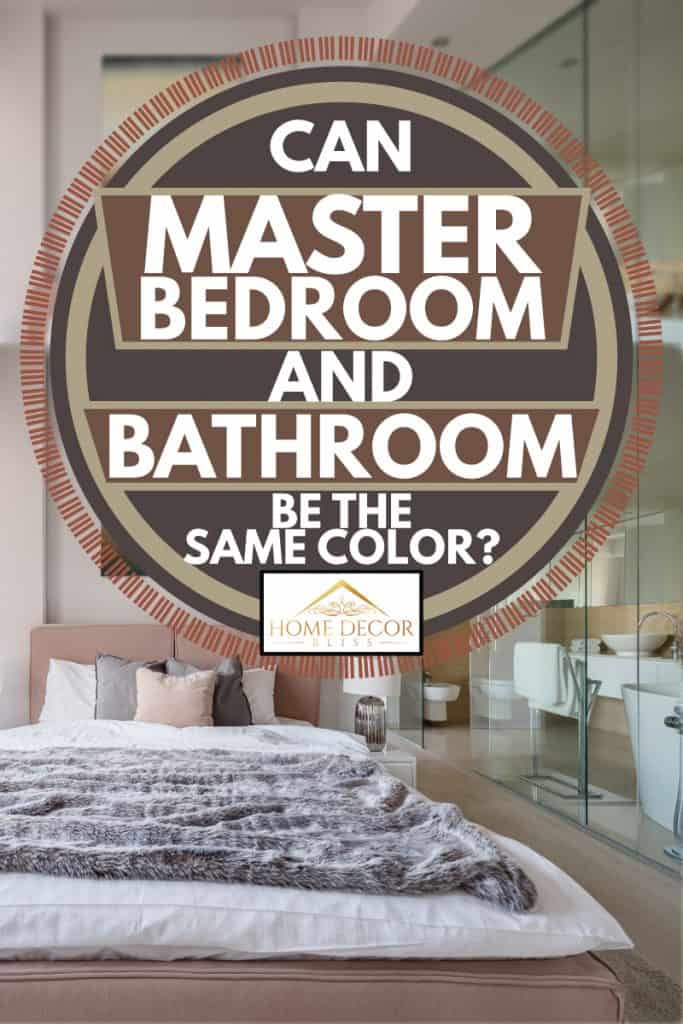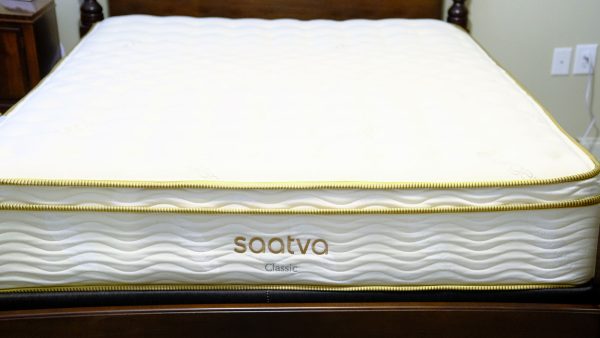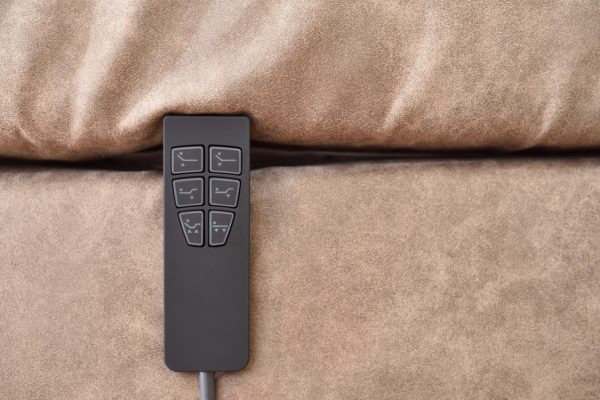Picking out your home's master bedroom and bathroom decor is exciting, but it can also be overwhelming. There are so many options. If you like a color, is it okay to use it for both rooms? We've consulted with the experts to bring you the answer.
Master bedrooms and bathrooms can be the same color or they can be totally different - it's ultimately up to you. If you'd like some cohesion between the rooms, it's recommended that you use the 60-30-10 rule (60% the dominant color, 30% a supporting color, and 10% an accent color) so that the two rooms are the same style without having too much of one color.
This is your home and you are welcome to decorate it any way you like, but we're here to help. Below, we provide a deeper explanation of the 60-30-10 rule and examples of potential color schemes that you can use. So, without further ado, let's get to it.

Master Bedroom And Bathroom Color Schemes
As we mentioned, the color scheme between these two rooms is ultimately up to you. There are great color options whether you use the same color for both rooms or switch things up. The 60-30-10 decorating rule is the best way to tie the rooms together. Let's take a look at what that looks like.
What Is The 60-30-10 Decorating Rule?
The 60-30-10 decorating rule is a method of deciding the color scheme for a particular room or home. Though it is called a "rule," take it more as a guideline instead of a law.
The dominant color in a room should cover about 60% of the available space. For a bedroom, think in terms of walls, the bedspread, large furniture, or an area rug. For a bathroom, think about walls, shower curtains, countertops, or cabinets.
The secondary color should occur about half as much as the dominant color. It gives the room depth and makes it interesting. In bedrooms, this would be nightstands, curtains, bedsheets, an accent wall, or the trim. In a bathroom, this would be towels, an accent wall, small rugs, or maybe the shower curtain (if you need more of the secondary color).
Finally, about 10% of the room should be an accent color. This can be a bright, popping color that spices up the space. Think about throw pillows, lamps, frames, or potted plants for a bedroom; and decorative bowls, soap dispensers, and toothbrush holders in a bathroom.
Breaking The Rule
The 60-30-10 rule is, like many rules, meant to be broken. It is simply a recommendation for how to look at your bedroom and bathroom.
Consider adding another tone to the secondary or accent color. This bedroom almost follows the 60-30-10 rule but has two accent colors: the dark coral of the throw pillows and the light wood of the bed frame:
If you like a paint color, a piece of furniture, or an accessory that doesn't fit in with your color scheme or it throws off your percentages, that's okay. Simply use this as rule as a starting point, then trust your own judgment.
Feel The Rooms
Creating cohesion between the two rooms is often about more than the paint color; it's also about style. Going from a farmhouse style bedroom into an ultra-modern bathroom can be jarring and unattractive.
For more information on this topic, check out Should Bedroom And Bathroom Decor Match?
Bedrooms and bathrooms are used for very different purposes, obviously, and you might not want to treat them the same way. For instance, you might want a calming, peaceful bedroom environment. This means softer, more pastel-like tones, and maybe some darker secondary and accent colors.
But in a bathroom, it's helpful to have plenty of light to be able to see clearly (nobody wants to apply makeup or shave in the dark - ouch!). You also don't want a color that will influence the light too much since bathrooms are typically smaller areas. A higher concentration of dark green or brown will throw off the lighting in the bathroom.
So instead of forcing a darker color into your bathroom scheme, try focusing on the style. This bedroom contains quite a bit of dark gray and black, which might not be ideal in your bathroom. Instead, focus on the blush color, geometric patterns, and soft lighting as inspiration for your bathroom:
Think Practically
Unless you are willing to purchase all new furniture and accessories for your bedroom and bathroom, it is often best to base your design on what you currently have. If you have a black bed frame, for instance, consider utilizing black as your secondary color, like in this room:
Are you willing to make drastic changes to permanent elements such as light fixtures, faucets, handles, countertops, or cabinets? If not, try to factor those factors into your plans. Decide on your budget and know what you are willing to change, then focus on building the design around the permanent elements.
If you have a light gray marble countertop in your bathroom, why not let it influence the colors in your bedroom like the one below?
Let your limits drive your creativity!
What Is A Good Dominant Color?
When picking a dominant color for your bedroom and bathroom, keep in mind that the dominant color in most rooms should be something earthy, pastel, light, or white.
Unless you're going for a very specific feel, the dominant color probably should not be pitch black or lime green. But if you want to go bold, go for it. This is your home and it should express your personality.
Otherwise, look for light grays, sky blues, off-whites, pastel purples, soft browns, or other similar colors for the dominant group.
Then, you can pick a color that supports the dominant color. Look either for an opposite color (using a color wheel like this one), a different shade of the same color, or a color that gives the dominant color some depth.
For more ideas on how to design your bedroom, check out these 31 Awesome Decorating Ideas for Large Master Bedrooms.
What Is The Most Romantic Color For The Master Bedroom?
When you think of romantic, you probably think of red or pink. These are great colors to use for a romantic master bedroom but could be overbearing when used as the dominant color. Look for ways to feature red or pink as a secondary or accent color with a more neutral dominant color such as grey, beige, or white.
This buffalo plaid bedspread looks cozy and welcoming amongst the subtler tones of grey and off-white.
We may include affiliate links and curated AI content to highlight top design styles.
Click here to purchase this bedspread on Amazon.
Similarly, this pink bed set looks romantic and inviting with the calmer tones in the room.
Click here to purchase this bedding set on Amazon.
What Is The Most Calming Color For The Master Bedroom?
When choosing a master bedroom color, avoid harsh, too-bright colors that cause stress on the eyes. Find a happy medium between fun and boring that makes the room interesting without being blinding.
Try a cream or off-white color that you can pair with a warm secondary color and a bright accent. Notice how this room uses cream, beige, and mauve to create a calming environment without grating the eyes:
If you're looking for something a little more fun, try a light, dusty blue. Pair it with a natural green plant like the room below for some variety:
What Is The Most Relaxing Color For A Bathroom?
For a relaxing bathroom color, try a light grey, sky blue, or pale yellow. Aim for a color that is not too harsh or too dark, since light is very important in bathrooms. Also, keep in mind that the bathroom is usually a smaller room, so paint colors are more amplified.
See how this bathroom uses a light blue color without letting it take over the room? It's fun and relaxing without dominating.
Check out this light yellow bathroom for inspiration. Notice how the color is light enough to keep the room bright without being blinding.
The Choice Is Yours
Keeping basic design principles like the 60-30-10 rule in mind can help make your master bedroom and bathroom decor unified without being overwhelming. But remember that it's your home to design however you'd like! Be practical, be flexible, and trust your instincts.




